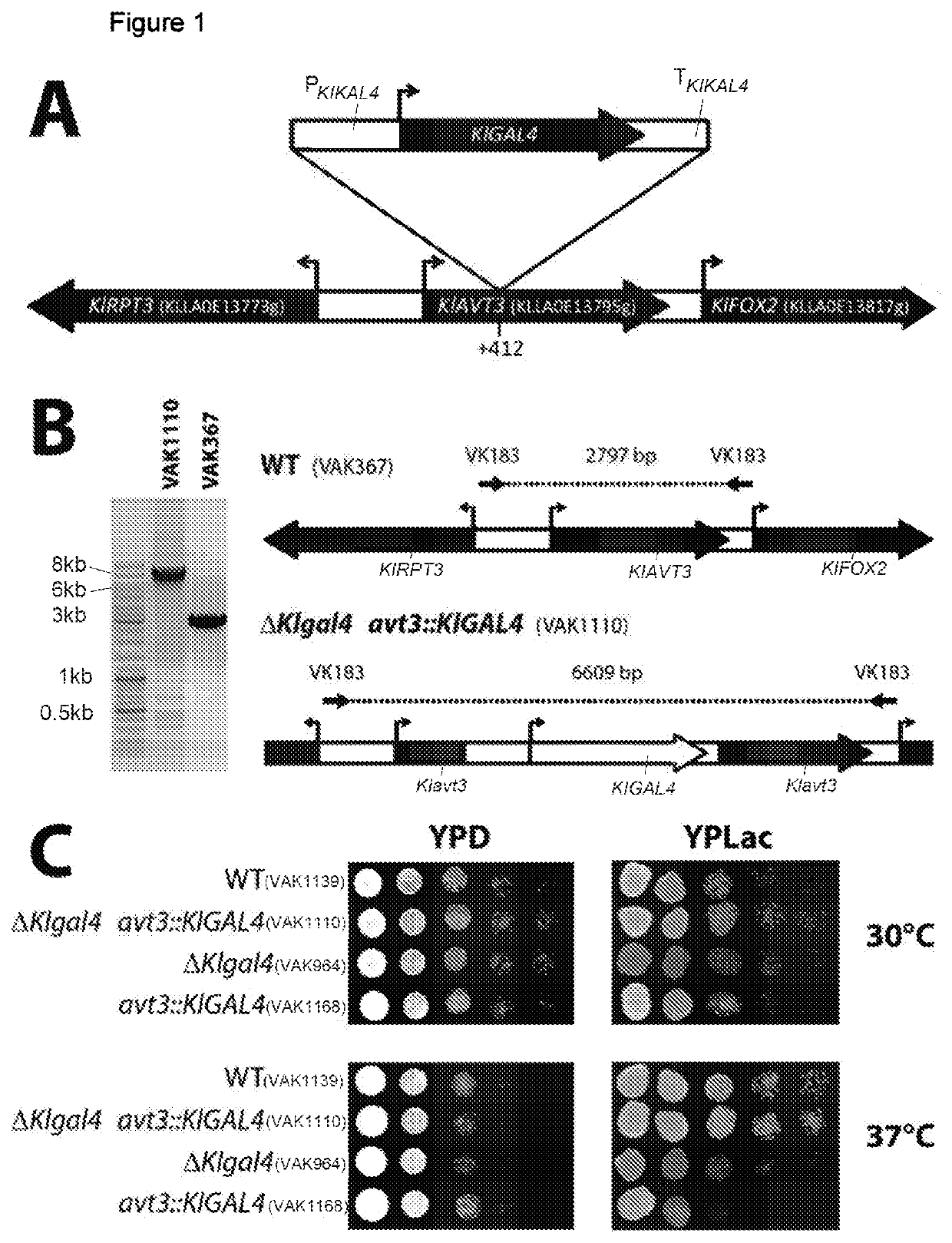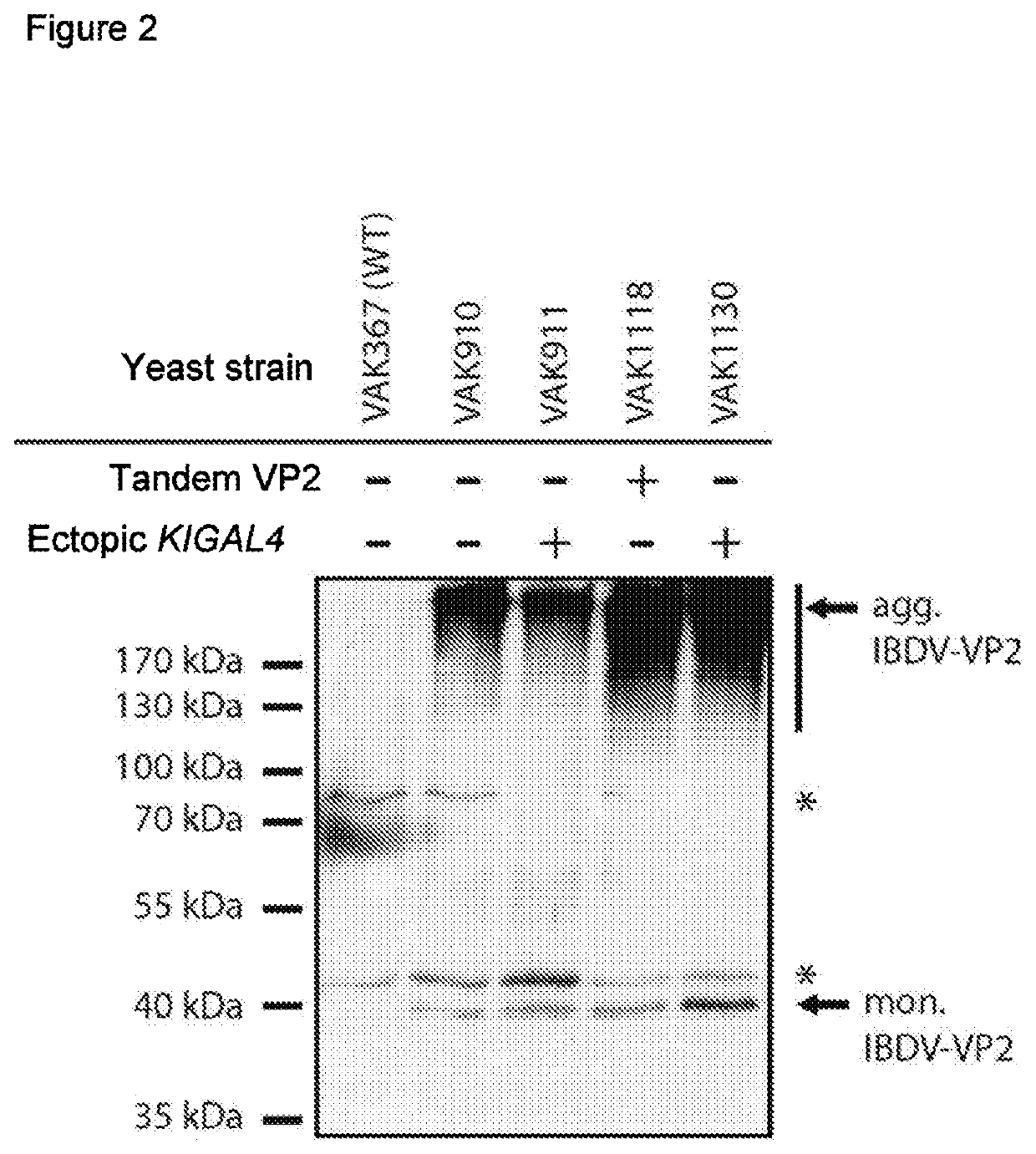Optimized host/vector system for producing protective mono- and multivalent subunit vaccines on the basis of the yeast kluyveromyces lactis
a technology of kluyveromyces lactis and host/vector system, which is applied in the field of recombinant kluyveromyces lactis, can solve the problems of unusable early warning system based on the detection of new infections, unfavorable vaccinating individual or pathogen undetected reactivation, complex production process, etc., and achieves the reduction or avoidance of cytotoxic effects conventionally caused by excessively strong expression
- Summary
- Abstract
- Description
- Claims
- Application Information
AI Technical Summary
Benefits of technology
Problems solved by technology
Method used
Image
Examples
example 1
n of a Host StrainHhaving Two KIGAL4 Gene Copies, Stably Integrated, at Noncoupled Gene Loci
[0127]A second KIGAL4 gene copy without a selection marker was inserted at a different gene locus (ectopically). It was possible to locate the insertion in the KIAVT3 gene (KLLA0E13795g) by sequencing (KIavt3::KIGAL4-1, SEQ ID No.: 1) (FIG. 1). The resultant strain is called VAK1111. The independent meiotic segregation of the two KIGAL4 copies, which are on chromosome E (ectopic copy) and D (genomic copy), was confirmed by a crossing experiment. Moreover, in the same experiment, the number of exactly two KIGAL4-1 gene copies in the genome was established. To use VAK1111 for the targeted integration of an expression cassette at the LAC4 locus in analogy to VAK367-D4, the lac4::ScURA3 disruption was introduced, which makes it possible in one step, under selection for lactose growth, to integrate the desired foreign gene between LAC4 promoter and LAC4 reading frame by means of KIp vector technol...
example 1.1
oductivity of a Yeast Vaccine Strain Having an Additionally Integrated KIGAL4 Gene
[0128]In one exemplary embodiment, the IBDV-oVP2T2S (Arnold et al. (2012)) gene was inserted into the LAC4 locus of the strain VAK1123 (resultant strain VAK1130). It was possible to establish an increased production of IBDV-VP2 compared to the otherwise isogenic strain having only one KIGAL4 copy (VAK910). As comparison, strain VAK1118, which bears only one KIGAL4 gene, but two CDS VP2IBVD copies (see below), is additionally shown (FIG. 2).
Example 2: PLAC4-12LR2′ Promoter Having Reduced Basal Activity for Optimizing the Expression of Antigens Having a Cytopathic Effect
[0129]Heterologous protein production in microorganisms is problematic when this leads to a cytopathic effect (CPE). Therefore, the task faced is to find a way to decouple the antigen production phase from the biomass accumulation phase. Owing to the inducible LAC4 promoter, this is partially possible by a fed-batch fermentation process, ...
example 2.1
of the Basal (Noninduced) Expression of Antigen by a Modified Promoter
[0130]After integration of a tandem IBDV-VP2 expression cassette into VAK1124 (resultant yeast strain: VAK1131; see below and FIG. 7 for an explanation of the term ‘tandem expression cassette’), it was possible to show that the LR2 deletion in the LAC4-12 promoter leads to a strong reduction in VP2 protein production under noninducing conditions (FIG. 3B). With strains expressing the influenza A antigen hemagglutinin (VAK952 without LR2 deletion in the promoter, VAK1243 with LR2 deletion in the promoter), it was possible to show that the cytopathic effect of the influenza A HA antigen is suppressed and growth under noninducing conditions is improved as a result of the LR2 deletion (FIG. 3C).
Example 3: Versatile Vector System for the Targeted Integration of Multiple Expression Cassettes into the K. lactis Genome
[0131]As before for VAK367-D4 (Krijger et al. (2012), WO 20101054649), the yeast strain VAK367 forms the ...
PUM
| Property | Measurement | Unit |
|---|---|---|
| dry weight | aaaaa | aaaaa |
| OD | aaaaa | aaaaa |
| intracellular concentration | aaaaa | aaaaa |
Abstract
Description
Claims
Application Information
 Login to View More
Login to View More - R&D
- Intellectual Property
- Life Sciences
- Materials
- Tech Scout
- Unparalleled Data Quality
- Higher Quality Content
- 60% Fewer Hallucinations
Browse by: Latest US Patents, China's latest patents, Technical Efficacy Thesaurus, Application Domain, Technology Topic, Popular Technical Reports.
© 2025 PatSnap. All rights reserved.Legal|Privacy policy|Modern Slavery Act Transparency Statement|Sitemap|About US| Contact US: help@patsnap.com



